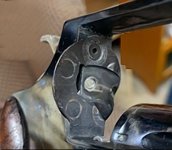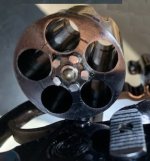For years I have wondered what causes these marks (see pictures) on the recoil shield. I have never owned one with these marks, but now and again they pop up for sale.
Friends and I have discussed this, and two basic thoughts keep surfacing. They are:
1) Shooting a lot of high pressure loads over a period of time, and
2) Simply carrying the revolver loaded for a long period of time, likely impacted by the composition of the shell casing.
I have seen this on revolvers that are well worn, as well as those that show minimal wear...... I am not able to determine from pictures if these marks are actually "worn through" the blue finish, or result from a deposit of material (nickel?) "on top" of the blue finish.
Does anyone have any first-hand experience with this? What actually causes it? Is it permanent wear or does it clean/polish off?
Your thoughts will be appreciated. Here are pictures (borrowed from the Internet) of a Chiefs Special recoil shield with the marks in question, as well as the cylinder in case it helps solve the mystery.




Friends and I have discussed this, and two basic thoughts keep surfacing. They are:
1) Shooting a lot of high pressure loads over a period of time, and
2) Simply carrying the revolver loaded for a long period of time, likely impacted by the composition of the shell casing.
I have seen this on revolvers that are well worn, as well as those that show minimal wear...... I am not able to determine from pictures if these marks are actually "worn through" the blue finish, or result from a deposit of material (nickel?) "on top" of the blue finish.
Does anyone have any first-hand experience with this? What actually causes it? Is it permanent wear or does it clean/polish off?
Your thoughts will be appreciated. Here are pictures (borrowed from the Internet) of a Chiefs Special recoil shield with the marks in question, as well as the cylinder in case it helps solve the mystery.


